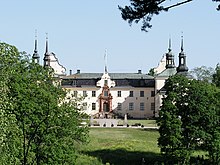Maria Sofia De la Gardie


Maria Sofia De la Gardie (1627 – 22 August 1694) was a Swedish
Biography
Early life
Maria Sofia De la Gardie was born to count
Life at court
After the death of her spouse in 1648, she became the guardian of her two underage daughters and responsible of the vast estates of the family. After the death of her father in 1652, she was given the responsibility of several estates also after him, making her one of the greater landowners in Sweden.
Maria Sofia was described as a great beauty, temperamental, forceful and talented, and could speak both French and German fluently. She was close to her brother Magnus Gabriel, the favorite of the monarch, and it was possibly because of him that she was showered with gifts from the monarch. She was given an allowance which helped her sort out her affairs, and her late spouse was posthumously granted the title of count, giving her the title and rank of precedence of countess at court. In 1651, she was appointed head lady-in-waiting, first with the title Court Mistress (Hovmastarinna) but soon with the title Chief Court Mistress (Overhovmastarinna), the highest office for a female at the royal court, though it was split on several people during the reign of Christina. She often hosted the queen at her residence Tyresö Palace, were the monarch liked to hunt.
In 1649, there was reports of a possible marriage with the heir to the throne, future King
It is known that she passionately supported her brother when he fell from grace in 1653, but this does not seem to have affected neither his nor her own position. With some exceptions, such as Ebba Sparre, lady Jane Ruthven and Louise van der Nooth, Christina did not show any interest in her female courtiers, and generally mentions them only to express contempt over their femininity and portray herself as more masculine than them. After the abdication of Christina in 1654, Maria Sofia left court to devote her life to her industrial interests, for which she has become known in history.
Industrial activity
Maria Sofia De la Gardie resided in Tyresö Palace, from where she managed her estates around the Baltic Sea. On her brothers' suggestion she made a study trip to the Netherlands, to study the industrial life. She was interested in cattlebreeding and gardening. She managed glovemaking and a brassmakery. Her most successful enterprise was a textile industry: by the energy of waterfalls on her estate, she manufactured broadcloth and textiles which were used to equip the army.
During the 1650s, De la Gardie engaged in banking activity and competed with her competitor, Stockholms Banco, by taking up large loans in the bank and then using the sums by lending it to the customers in her own bank: this was initially very lucrative, but eventually, problems enabled the Stockholms Banco to confiscate and sell her banking security.[4]
Maria Sofia De la Gardie took part in the pacification of
During the famous
At the
See also
- Margaretha Donner
- Margareta von Ascheberg
References
- ^ "Mer om Maria Sophia De la Gardie". Stockholm länsmuseum. Retrieved 1 April 2019.
- ^ Maria Sjöberg. "Maria Sofia De la Gardie". Svenskt kvinnobiografiskt lexikon. Retrieved 1 April 2019.
- ^ Svante Norrhem. "Ebba Brahe". Svenskt kvinnobiografiskt lexikon. Retrieved 1 April 2019.
- ^ Du Rietz, Anita, Kvinnors entreprenörskap: under 400 år, 1. uppl., Dialogos, Stockholm, 2013
Other sources
- Marie Sophie De la Gardie, urn:sbl:17384, Svenskt biografiskt lexikon (art av B, BoiiTHius.), hämtad 2013-11-28.
- Ellen Fries: Svenska Kvinnor ['Swedish women'], utg av S.Björklund, (1920) (in Swedish)
- Jan Guillou: Häxornas försvarare ['Defender of the witches'] (in Swedish)
- Wilhelmina Stålberg: Anteckningar om svenska qvinnor ('Notes on Swedish women'] (in Swedish)
Further reading
External links
 Media related to Maria Sofia De la Gardie at Wikimedia Commons
Media related to Maria Sofia De la Gardie at Wikimedia Commons
